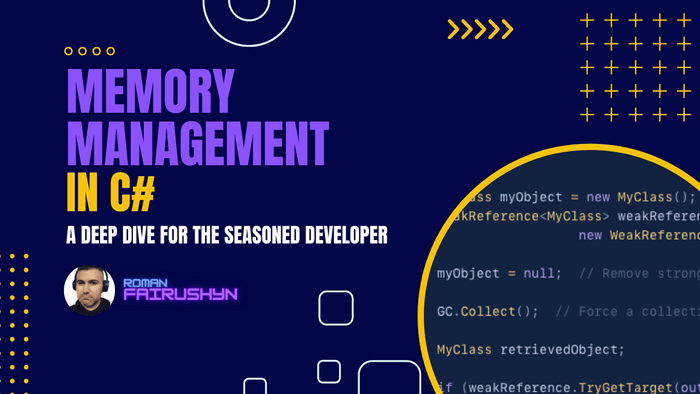Memory Management Deep Dive in C#
3 min read · — #csharp-interview#middle-specialist#memory-management#stack#heap#large-object-heap#small-object-heap#weak-references#Lazy<T>
Introduction: To the seasoned software engineer, understanding memory management is like a musician mastering the nuances of their instrument. It's no longer about playing the right notes; it's about expressing the deep and subtle beauty of the piece. Similarly, when we look into the intricacies of memory management in C#, we're looking beyond simple allocations and deallocations. We're diving into the symphony of stack, heap, large and small object heaps, weak references, and the art of lazy evaluation. So, Engineers, grab your conductor's baton (or your keyboard) as we delve deep into the world of C# memory orchestration.
1. Stack & Heap:
Stack: A region of process memory where local variables are stored. The stack grows and shrinks automatically, pushing (adding) and popping (removing) items as functions are called and return.
Example:
public void MyFunction() {
int localVariable = 42;
// This variable lives on the stack.
}Heap: A region of process memory where objects are allocated. This memory must be managed, and in the context of C# and .NET, this management is done via the garbage collector.
Example:
public void MyFunction() {
MyClass obj = new MyClass();
// 'obj' reference is on the stack,
// but the object itself is on the heap.
}2. Large Object Heap (LOH) & Small Object Heap (SOH):
Small Object Heap (SOH): The .NET garbage collector divides the heap into two sections: SOH and LOH. SOH is where small objects (typically less than 85,000 bytes) are allocated.
Large Object Heap (LOH): Any object that's 85,000 bytes or larger is considered a large object by .NET. Such objects are allocated directly on the LOH. This distinction is made because compacting large objects can be performance-costly, so the LOH is not compacted as frequently as the SOH.
Example:
byte[] smallArray = new byte[80_000];
// This will be allocated in the SOH.
byte[] largeArray = new byte[100_000];
// This will be allocated in the LOH.3. Weak References:
A weak reference allows the garbage collector to collect an object while still allowing the application to access it.
It's useful when you want a cache-like behavior. If the object is collected, the weak reference returns null.
Example:
MyClass myObject = new MyClass();
WeakReference<MyClass> weakReference =
new WeakReference<MyClass>(myObject);
myObject = null; // Remove strong reference.
GC.Collect(); // Force a collection.
MyClass retrievedObject;
if (weakReference.TryGetTarget(out retrievedObject)) {
// The object is still in memory.
} else {
// The object was collected.
}
4. Lazy:
Lazy<T> is a wrapper that provides support for lazy initialization. It creates the instance of the type when it's
accessed for the first time, which can be useful to delay expensive computations or initializations.
Example:
Lazy<MyClass> lazyInstance = new Lazy<MyClass>(() => new MyClass());
// At this point, MyClass's constructor hasn't been called yet.
MyClass instance = lazyInstance.Value;
// Now, MyClass's constructor is called.Conclusion:
In conclusion, understanding these intricacies can deeply affect the performance, scalability, and reliability of your C# applications. As engineers, having this knowledge in your toolkit allows you to craft not just functional, but optimal solutions for complex scenarios. Good luck with your technical interview, and may the memory be always in your favor!
References
- Under the Hood of .NET Memory Management CLR Via C#, Chapter 21
- Fundamentals of garbage collection
- The large object heap on Windows systems
- Weak References
- Lazy Initialization
- Lazy
Class
